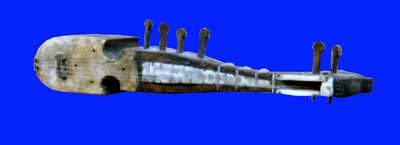
|
Rabab is a very ancient instrument found primarily in
Afghanistan but in India is common in Kashmir. It is a hollowed-out
body of wood with a membrane stretched over the opening.
Combinations of gut (or nylon) and metal strings pass over a bridge
which rests on a taught membrane. The rabab is mentioned quite
frequently in old texts. However this is usually the seni rabab
which is different from what we think of today. It is common to
refer to the modern rabab as the kabuli rabab to distinguish it from
the seni rabab. opening.
Combinations of gut (or nylon) and metal strings pass over a bridge
which rests on a taught membrane. The rabab is mentioned quite
frequently in old texts. However this is usually the seni rabab
which is different from what we think of today. It is common to
refer to the modern rabab as the kabuli rabab to distinguish it from
the seni rabab.Although the kabuli rabab is the style that is normally thought of today, over the centuries the term has been applied to a variety of instruments. Therefore as a generic term it has been applied to a variety of instruments that even impinge upon the sarod and the sarangi.
There is evidence that this instrument may be the progenitor of a number of Indian instruments. The saringda, sarod, and the sarangi are the ones most commonly attributed to this instrument. At first it may seem hard to make the connection between a plucked instrument and a bowed instrument, however notice the "waist" in the middle of the rabab. This is an indication that the instrument at some time was played with a bow. All bowed instruments must be narrow at the place where the bow must pass. |
||